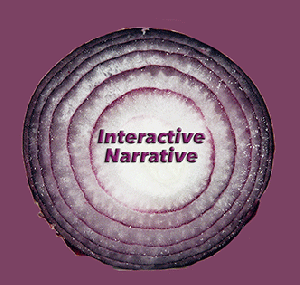 Building on the definition my partner and I developed in an early class, I define interactive narrative as: A story that uses digital media to engage the audience in a user-centric experience that motivates them to follow a linear or non-linear path, which ultimately achieves stakeholders’ goals.
Building on the definition my partner and I developed in an early class, I define interactive narrative as: A story that uses digital media to engage the audience in a user-centric experience that motivates them to follow a linear or non-linear path, which ultimately achieves stakeholders’ goals.
What I’ve since discovered is how interactive narrative adds multiple dimension to traditional storytelling. Like most stories, it has place, characters and plot but there are various layers within each.
Place can entail the user’s mindset, physical surroundings or device through which they’re experiencing it. (I was also fascinated to learn about Microsoft’s research into four cross-screen engagement pathways, which slice the place layer yet again.)
The hero or central character is always the user and may be alone or one of many. Stakeholders and partners also play pivotal roles, often as masterminds behind the experience.
And the plot is rendered through: varied levels of interactivity, prompts for open or closed input, metaphors, emotions and communication that imparts knowledge and elicits change. I never thought that each story or experience we encounter creates change and some form of new knowledge. I also have a new respect for latent knowledge and the long-term value it provides. I think it’s interesting how an interactive experience can ‘wake-up’ this latent knowledge and connect it to conscious thought.
Through various in-class exercises and assignments, I also gained a greater “hands-on” understanding of interactive narrative and how it can effectively integrate with technical solutions, websites and apps. Many of them made me to consider technology in different ways.
For example:
- Assessing interactive experiences in terms of audience numbers and levels of interactivity showed me the range of options. It also made me recognize even minute levels of interactivity, such as Banksy’s provocative streetscape murals.
- The final assignment with the three somewhat conflicting variables of: responsiveness versus resolution; optimization versus ubiquity; and customization versus design, forced me to look at tradeoffs to consider and mitigate in each project.
- Moving projects to another place or for another stakeholder gave me a new approach for brainstorming new ideas both online and offline.
Although I still face ‘writer’s block’ when I begin to sketch out an interactive concept or wireframe, in class exercises, such as developing a user flow, storyboard or user’s journey helped jolt me forward. Developing a user flow for my senior project and then opening it to critique from my team proved beneficial. During this exercise, my team members highlighted the opportunity to integrate a search process differently and skip a step, which I might have otherwise missed, possibly because I’m so close to it. With this third-party insight, I developed a smoother search option, which plays out well in my prototype.
Most importantly, learning about interactive narrative and its many layers has given me new insight into how we are potentially moving toward a rich era of co-creation, where designs are created by diverse people/teams. And if this optimistic predication proves true, I can’t wait to see how the world improves as we advance toward it.
